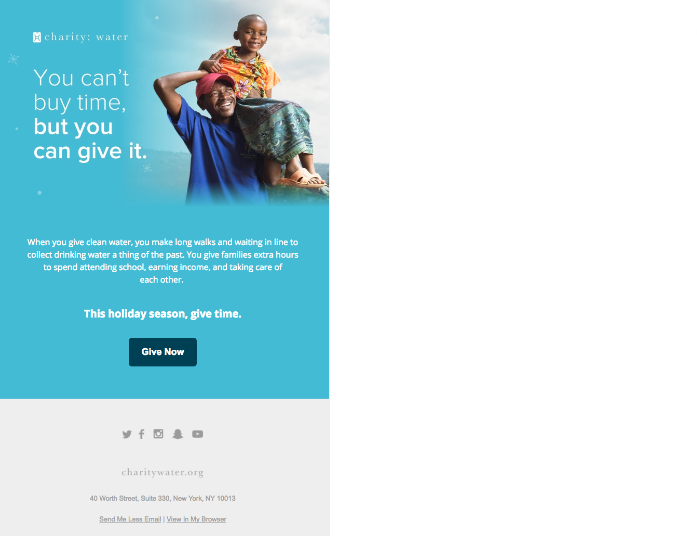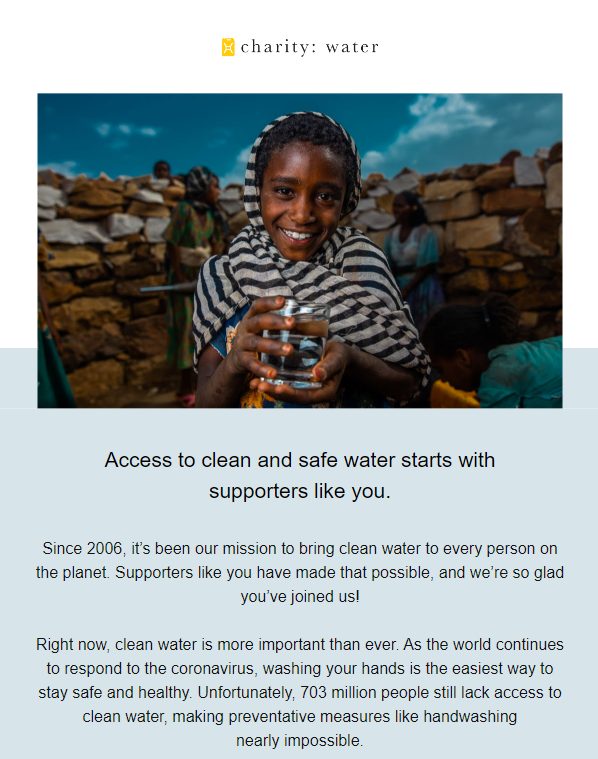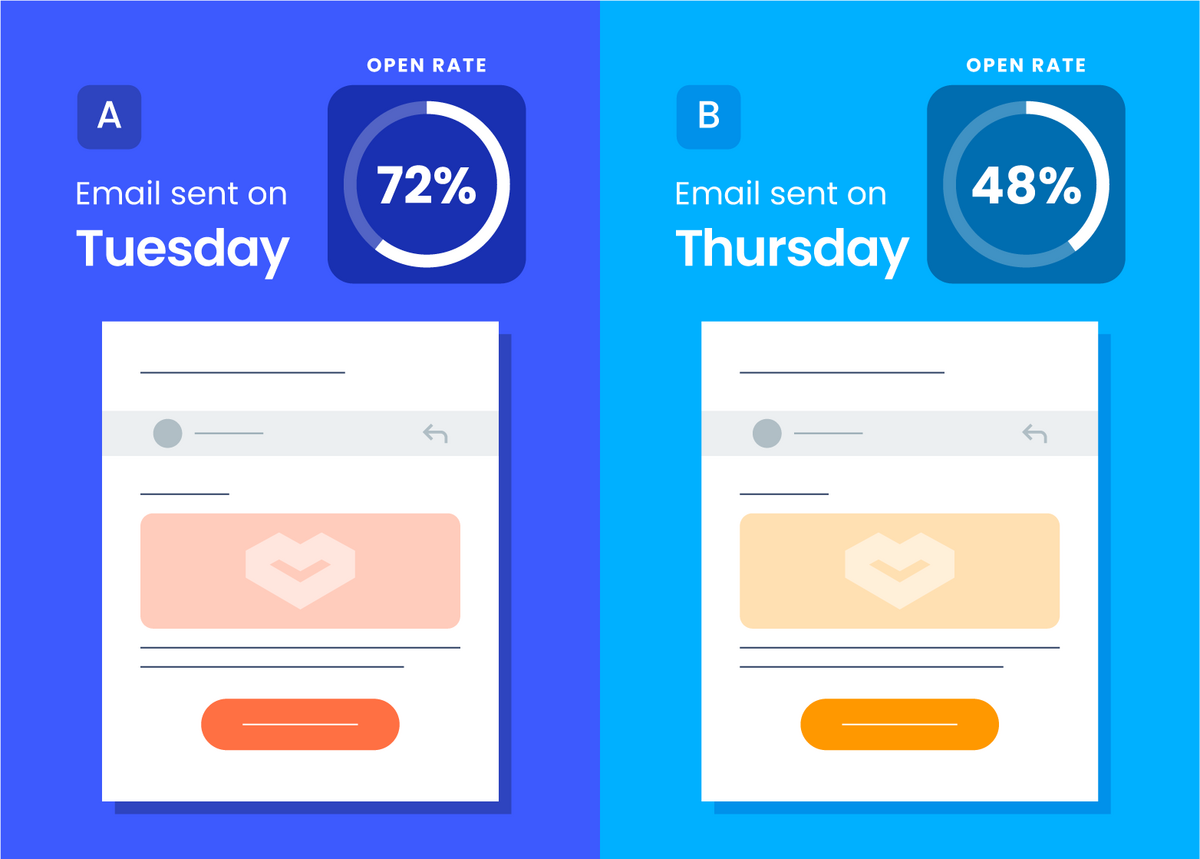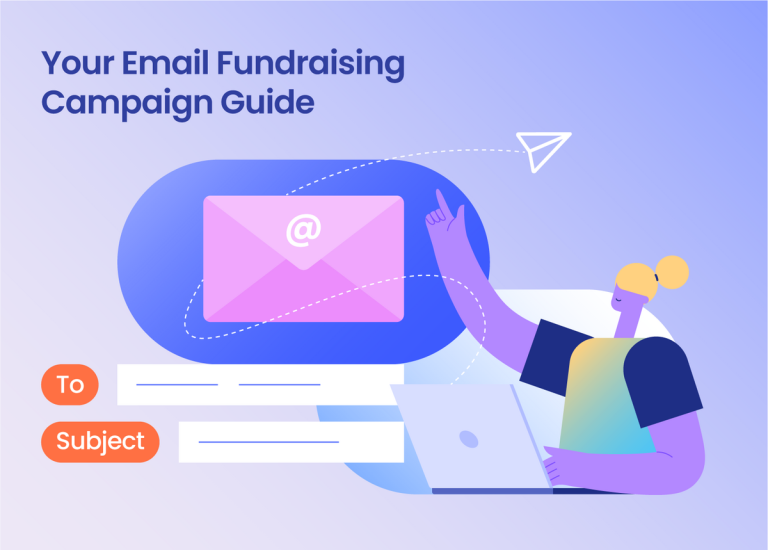Think about it. How often have you clicked on an ad or an email to purchase? Far more often than you’ve stumbled across a store or event and purchased something, right?
An email fundraising campaign makes it easy for donors to give and engage.
Today, we’re sharing everything you need to know about crafting an effective email fundraising campaign for your nonprofit, from how to craft magnetic subject lines that boost your campaign’s visibility to how to create engagement, ways to personalize, and more.
Let’s get started!
- Crafting the Perfect Fundraising Email
- Design Elements That Drive Donations
- Maximizing Email Open Rates Through Timing and Testing
- Analyzing Campaign Performance Metrics
- Create Fundraising Campaign Emails That Change the Game for Your Organization with the Right Tool
Crafting the Perfect Fundraising Email
Every email you send to your donors is an opportunity. It’s a chance to connect, inspire, and persuade. So, how do you make your emails as effective as possible?
Start with a compelling email subject line
You can craft the most magical and moving email content in the world, but if your donors don’t open the email, all that effort has gone to waste.
Your subject line works like a headline in a newspaper; it must catch the eye in an inbox full of distractions.
EXERCISE:
Create a blank Google Doc or grab a notebook – separate the page into two columns. One is for the subject line, and one is for motivation.
Go through your email inbox and make a list of 20 great email subject lines from emails you’ve opened recently. Write them down in column one.
Then, next to each subject line you select, write down what made you click on an email in column two. Was it curiosity or urgency? Perhaps the promise of something valuable inside?
Put your findings into action. Use those same triggers when crafting your own fundraising campaign emails.
Ensure that you put priority on personalization
This isn’t just theory; stats show us that such tailored greetings are something humans crave. In fact, nearly ¾ of people get annoyed when their email experience isn’t personalized. When dealing with donors, this isn’t a frustration you can risk!

You want to make every single message feel more like a one-on-one conversation than a broadcast aiming at no one in particular.
Here are some places you can personalize:
- Subject line
- Opening address
- Closing address
- Giving amounts (if you have a donor CRM that will pull this information for you!)
And this may seem obvious, but ensure your entire donor list is on your fundraising email list! It’s a good idea to audit periodically to ensure no one is missed. Make sure you ask for an email address every time your organization engages with potential donors!
Craft email content that tells a story
An effective fundraising letter tells a story where readers see themselves as protagonists helping achieve something remarkable through their support. By weaving narrative elements into every part of your message—from strong opening lines to compelling images—you invite supporters into an experience rather than merely asking them for help.
You do this in your annual appeals, your press releases, and your website—carry it through your emails, too.
Feeling overwhelmed with where to start with storytelling?
There’s an easy fix:
Testimonials from both donors and those impacted by your work tell a great story.
By showing your email recipients real stories from those impacted by donations, you’re not just asking for money; you’re inviting your audience into a narrative where their contribution has a meaningful impact.
On the other hand, inspiring action through stories from beneficiaries or other donors adds a layer of trust to your appeal. People are more likely to donate when they see that others have done so and witnessed positive outcomes. These shared experiences become powerful tools that resonate deeply with potential contributors.
A testimonial can transform abstract statistics into relatable narratives in the reader’s eyes.
And the best part? You do not have to come up with the stories on your own.
They’re already written; they just need transcription.
Make your impact highly visible
Next up is making sure people can physically see your impact with engaging visuals—or see the reason why your cause is necessary.
Think about the emails you get from an organization like Charity Water. They incorporate images of humans impacted. Showing them filled with joy and explaining how their lives have changed thanks to clean drinking water. That inspires giving!


Incorporate visuals judiciously but impactfully within the body text so mobile device users—who might delete poorly optimized content—can also engage fully without trouble on smaller screens.
Compelling images paired with great stories strike chords. They transform abstract numbers and statistics into tangible evidence showing positive impacts made possible thanks to generous contributions from people like them.
This is a surefire way to capture donors’ attention and drive action toward achieving nonprofit fundraising goals.
If you don’t have your own images quite yet, use stock photos from Unsplash or Pixabay to pull at the heartstrings of every prospective donor.

Create a strong CTA
A call-to-action, or CTA, is a prompt to encourage donors to take the action you’re hoping for. That could be signing up for more information about a campaign or actually giving. Whatever your goal is!
Creating a strong call-to-action (CTA) is vital for nonprofits in their fundraising campaigns as it directly influences donor engagement and conversion. A compelling CTA serves as the catalyst for action, guiding potential supporters toward donating or getting involved with the cause.
Here are a few you can use:
- Donate now
- Your donation matters
- Give here
- Time is running out to donate
- Sign up now
- Don’t miss it
Design Elements That Drive Donations
Now, beyond the words and visuals, there are a few things you want to consider when it comes to design.
Optimize for mobile
Remember, your fundraising email is a digital handshake with potential donors. It’s crucial that every aspect of it, from the email template to the donate button, feels inviting and functions flawlessly. Especially when you consider that over 40% of recipients may delete an email if it doesn’t display well on their mobile device.
So, how do you optimize? Here are a few things to consider:
- Responsive design: Ensure that your email template is responsive, meaning it adjusts its layout and formatting dynamically to fit the screen size of various mobile devices. This ensures readability and usability across different screens, enhancing the user experience.
- Touch-friendly buttons and links: Make sure that any buttons or links included in your email are large enough and spaced adequately to be easily clickable on a touchscreen device. This helps prevent frustration and encourages interaction with your email’s call-to-action (CTA) or links.
- Clear and concise content: Mobile users typically have shorter attention spans, so it’s essential to keep your email content concise and to the point. Use clear headings, bullet points, and short paragraphs to make it easy for recipients to skim through and grasp the main message quickly.
Creating fundraising email templates
An intuitive layout guides readers effortlessly through your message towards making a donation. This means balancing compelling images with text while leaving plenty of white space—creating an experience as visually appealing as it is informative.
Once you find a design that works, save it as a template and use this to guide every email!
Make “donate” or other important buttons stand out
The heart of any fundraising campaign lies in its ability to drive donations efficiently—and that’s where the design around your donate button comes into play.
Highlighting this feature using bold colors or unique shapes can grab attention and simplify the giving process for users who are ready to support your cause right away.
Incorporating these design principles isn’t just about aesthetics—it’s about crafting an experience that resonates on both desktops and mobile devices alike, fostering trust through ease of use and professional presentation, which ultimately encourages generosity among those looking to contribute towards meaningful causes.
Optimize for social media integration
Expanding your reach and fostering multi-channel engagement are key to a successful online fundraising strategy. Coordinating your email and social media efforts can open doors to new audiences, who may resonate with different aspects of your mission.
To integrate effectively, start by including social sharing buttons in all of your fundraising emails. This simple addition makes it easy for recipients to spread the word on platforms like Facebook or Twitter with just one click.
When using a proper email marketing system like Stratly offers, you’ll be able to save this so it automatically populates for each email, saving time and effort.
Promoting exclusive content through both email and social channels can also drive traffic back and forth—teasers on social media can direct followers to sign up for more detailed information via email campaigns, thus growing your list organically.
Maximizing Email Open Rates Through Timing and Testing
Okay, now you have a great subject line, compelling content, and a strong call to action. What’s next?
Well, you want to test it out, so you may need to create more versions of the above.
It’s been shown that the average open rate (how many people open your emails) for a nonprofit is 28.59%, and the click-through rate (how many people click a link in the email) is 3.29%. Use this as your benchmark; you want your numbers to be here or better!
A/B testing is a highly effective method to determine the best strategies for engaging your audience through email campaigns. By tweaking elements like subject lines or send times, you can pinpoint what resonates most with your recipients.
Here are things you may want to test:
- The time you send the email
- Subject lines
- Call-to-actions
- Email content
Factors that drive open rates vary among audiences, so this data-driven approach ensures email sends align with unique recipient behaviors.
Harnessing the data from A/B testing
In practice, A/B testing involves creating multiple versions of an email. Each has slight variations that could affect how well they perform.
Maybe version ‘A’ gets sent out on Tuesday morning while version ‘B’ goes out Thursday afternoon; perhaps they feature different subject lines or calls-to-action (CTAs).

Then, measure which version had a higher open rate or better overall engagement—it’ll guide future campaign decisions toward more personalized touches and stronger connections with potential donors.
This strategic experimentation doesn’t just guesswork but relies on concrete numbers—a nonprofit marketer’s gold mine.
Knowing there’s evidence suggesting Mondays yield great results gives you a solid starting point to optimize campaigns around those high-response opportunities!
Fine-tuning your strategy for success
Beyond identifying ideal send times via A/B testing, a deeper dive into metrics will reveal other critical factors driving success like:
- How many donations resulted from each variation?
- Which format prompted readers to spend more time perusing content?
These insights highlight not only optimal timings but also elements worth replicating across future communications to enhance online revenue streams efficiently.
Analyzing Campaign Performance Metrics
Do you want a successful campaign? Track the following to start:
- Open Rate: The percentage of recipients who open the email.
- Click-through rate (CTR): Measure the percentage of recipients who click on links within the email.
- Conversion rate: Determine the percentage of recipients who take the desired action after clicking on a link within the email.
- Unsubscribe rate: Track the percentage of recipients who choose to unsubscribe from the nonprofit’s email list.
- Donation metrics: Evaluate donation conversion rate, average donation amount, and total revenue generated from email campaigns.
- Engagement metrics: Consider qualitative metrics like high response rates in the form of replies, forwards, and social media shares inspired by the email content.
- Deliverability: Ensure email deliverability by checking if your emails ending up in inboxes or spam.
Your fundraising goals aren’t static; neither should be your analysis methods. By consistently monitoring key stats over time, patterns emerge that inform smarter strategies going forward.
Use tools like Google Analytics alongside specialized nonprofit platforms like Stratly to help correlate data points such as donation amounts with specific emails sent out during different times of the year—like those high-response end-of-year appeals.
Create Fundraising Campaign Emails That Change the Game for Your Organization with the Right Tool
You’ve got great tools at hand now: powerful subject lines drawn from A/B testing results paired with compelling images that drive supporters’ attention toward strong donate buttons—all optimized for every device type.
A thorough review using these practices ensures not just immediate gains but sets a solid foundation for ongoing improvements in how effectively you engage potential donors and grow online revenue streams efficiently through well-executed email campaigns.
The key though?
Implementing software that can personalize, incorporate and track data and integrate seamlessly with your other platforms.
This is exactly what Stratly offers.
Schedule a demo today to experience the power for yourself.

